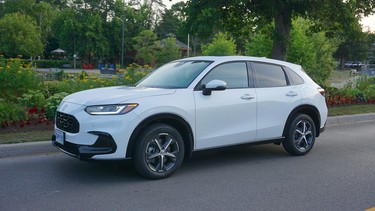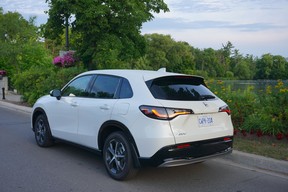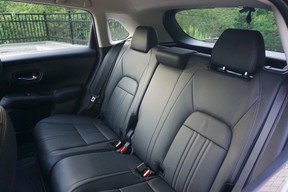Yes, there is more personality, but this small crossover still focuses on the fundamentals

Article content
Long ago during my 40-plus years of testing came the realization that some vehicles can be both really good and really boring. The first generation of Honda’s subcompact HR-V — or at least the Touring version of the crossover I drove several years back — was, in a segment that was rapidly expanding with sporty, cute urban runabouts, dull. I described it as “vanilla, with mainstream styling and more focus on utility than fun.” And then I hit it with the unkindest cut of all, suggesting it would find favour with an older demographic that appreciates a four-season runabout centring on the fundamentals — safe, reliable, easy to drive and reasonably priced for the content provided.
Advertisement 2
Article content
So, here we have the new-for-2023, second-generation HR-V, better in myriad ways in comparison with its forebear, yet still focusing on those same fundamentals. The thing is, in a segment even more saturated with competitive product, is being better than it was, while still looking rather mainstream, enough to placate the faithful while winning over younger consumers? The previous generation HR-V was a solid seller for Honda, well behind the numbers posted by the Civic and the larger CR-V crossover, but a player, nonetheless. Yet, nowhere near as popular with buyers as the Hyundai Kona, Subaru Crosstrek, Nissan Kicks and Qashqai, and Kia Seltos. And the Mazda CX-30 has been giving it a hard fight.
Advertisement 3
Article content
The new HR-V has a clean and generally understated styling to it — albeit with a somewhat ungainly nose — that might be a tad conservative for buyers looking for a ride that stands out. That said, the topline HR-V EX-L Navi ($37,130 before freight and PDI) manages to perk things up with a subtle application of gloss black — honeycomb grille, door pillars and front and rear bumpers all get the treatment. The EX-L Navi also sits on 17-inch painted (not gloss black) alloy wheels.
But move beyond styling and the crossover’s list of betterments is fairly impressive — bigger dimensionally with a larger, more responsive engine, a new platform with a smoother-riding independent rear suspension, and a cabin featuring digital instrumentation and Apple CarPlay and Android Auto integration. And while not put to use in the middle of an August heat wave, a new Snow driving mode has been added that alters the drive ratios and throttle mapping to maximize available traction in slick conditions.
Advertisement 4
Article content
Let’s start with the HR-V’s expanded size. The crossover now shares its architecture with the CR-V and Civic. Length has been increased by 221 millimetres, the wheelbase by 45 mm. The HR-V is 70 mm wider, and its front and rear tracks have been improved by 55 mm and 64 mm respectively. The result, assisted by the new fully independent rear suspension, is a noticeably compliant and stable ride, bettering that of its predecessor. It also significantly improves cabin comfort (more on this later).
Advertisement 5
Article content
The previous HR-V was powered by a 141-hp, 1.8-litre four-cylinder that provided acceleration best described as sluggish. The 2023 version receives the same engine and transmission as found in lower trims of the Civic — a 2.0L four-cylinder that puts out a usable 158 hp at 6,500 rpm and 138 lb-ft of torque at 4,200 rpm, mated to a CVT. Having an extra 17 hp and 11 lb-ft of torque, while also delivering lower emissions is a good thing, but the HR-V is still a walk on the mild side, on the low end of the zippy scale in comparison with the competition. OK, the subcompact crossover category isn’t known as a breeding ground for sportsters, and the Honda’s lack of grunt isn’t nearly as noticeable in city driving as it is patently obvious when merging onto a highway, where it makes a slow — albeit very smooth — climb to speed. As such it reinforces my thought the HR-V won’t be collaring too many adventure-seeking youth. Then again, Honda Canada’s marketing department isn’t laying on thick the adventure-seeking aspects of the soft-roader rig. Actually, the company says it expects the crossover “will be popular with … diverse consumers representing a variety of lifestyles.”
Advertisement 6
Article content
And you can count my wife as one of the diverse consumers who is quite taken with the HR-V. As detailed on Driving.ca, Diana and I have been trying out a bunch of similar-sized crossovers — Toyota Corolla Cross, Kia Seltos, Mitsubishi Eclipse Cross, Crosstrek, Kona, and CX-30 — trying to find the one best suited to deal with her particular needs, namely a petite stature and vision issues. With the usual pre-drive requirements out of the way — removal of rear-seat headrests, seat moved to maximum forward position, additional seat cushion in place — off we went. Immediately, I could sense she was comfortable with the way the Honda handled. In short, it’s painless to drive, with a light but direct touch to the steering that allows it to move easily through traffic.
Advertisement 7
Article content
-
![Family Vehicle Roundup: 2023 Honda HR-V, best rides for camping, and more]()
Family Vehicle Roundup: 2023 Honda HR-V, best rides for camping, and more
-
![Sizing up the 2023 Honda HR-V]()
Sizing up the 2023 Honda HR-V
Still, the real test was fronting into a parking spot, a big issue since Di cannot see out of her right eye, which compromises her peripheral vision as well as her depth perception. Fortunately, the 2023 HR-V comes standard with Honda Sensing driver assist and safety technology, which includes blind-spot information, rear cross-traffic monitoring, adaptive cruise control and the biggie for her, forward parking sensors, with a clear pictogram appearing on the central touchscreen, replete with loud warnings if getting too close to an object. No, it isn’t as sophisticated as the Mazda CX-30’s available Advanced Visibility Package, which comes with a 360º camera that provides an overhead view of the vehicle as well as forward/rear views, but the visual/audible cues provided by the HR-V’s forward sensors are clear and immediate — Diana found it more to her liking, and now the Honda moves to the top of her list.
Advertisement 8
Article content
Still, there is a criticism that must be levelled: The best safety feature found in the first-gen HR-V was itsLaneWatch system. Simply, anytime a right turn was signaled before changing lanes, a small camera on the passenger-side mirror turned on and displayed a live picture on the centre touchscreen, which made it far easier to detect pedestrians, bicyclists, etc., in the crossover’s blind spot. The system is not offered in the new model, Honda determining that the Honda Sensing suite of technologies more than compensates. I respectfully but strenuously disagree.

Honda notes that the HR-V’s interior is a fresh take on its “simplicity and something” design direction introduced with the 2022 Civic. Unfortunately, that also includes the monotony of an overwhelmingly black cabin with little in the way of visual relief. Yet, it’s not completely dreary thanks to the HR-V’s EX-L Navi’s sunroof, plus the large greenhouse, resulting in more light being let into the cabin and outward visibility better than what most of the competition offers.
Advertisement 9
Article content
The cabin features a wide instrument panel highlighted by a metal honeycomb mesh accent stretching from door to door. Instrumentation is clear and concise, and the various switchgear and controls are all legible and easy to access. A bonus for spending the extra bucks on the EX-L Navi trim is a larger nine-inch (as opposed to seven-inch) high-def colour touchscreen with wireless Apple CarPlay and Android Auto integration. A pass-through complete with USB charging ports is ideal storage for small items, such as a smartphone.
Kudos to the new “body stabilizing” seats that provide proper support in all the right places, reducing fatigue on longer drives. Yet, despite the tester’s $37K sticker, the seats are manually adjusted, no power operation even for the driver.
Advertisement 10
Article content

Now to the biggest improvement passenger accommodations-wise: Plenty of legroom for front- and rear-seat occupants. The problem with the first-gen HR-V was that it was far more comfortable for those up front to be of average or shorter height. At 6-foot-1 and even with the driver’s seat as far back in its track as possible, it was as though I was sitting in an armchair, OK for shorter distances, not so much on longer drives. Yet, in a kind of bass-ackward way of thinking. it was overly generous in the legroom department for those in the back seats. In the new model, no such issue.
But the extra stretch-out room seems to come at the expense of cargo capacity — the new HR-V has less than its predecessor, 1,559 litres when the rear seats are folded versus 1,665 litres for the first gen. And, again, considering the tester’s MSRP, the lack of a power-operated liftgate might be considered an oversight — my nearly five-feet-tall wife had to stretch to reach the door pull.
Advertisement 11
Article content
So, what’s the upshot here? On one hand, the new HR-V is a much more complete model than the one it replaces. But it sets no new benchmarks within the small crossover segment, doesn’t raise the bar. And while it has a bit more personality, it remains a four-season runabout primarily focusing on safety, reliability and easy driveability. Actually, make that really, really easy driveability. The moment I got behind the wheel it was if it had been in the family for years. More importantly — at least to me — Diana immediately took to it. This is about as rare as a sasquatch sighting. The HR-V has become her new favourite.
Stay connected with us on social media platform for instant update click here to join our Twitter, & Facebook
We are now on Telegram. Click here to join our channel (@TechiUpdate) and stay updated with the latest Technology headlines.
For all the latest Automobiles News Click Here



